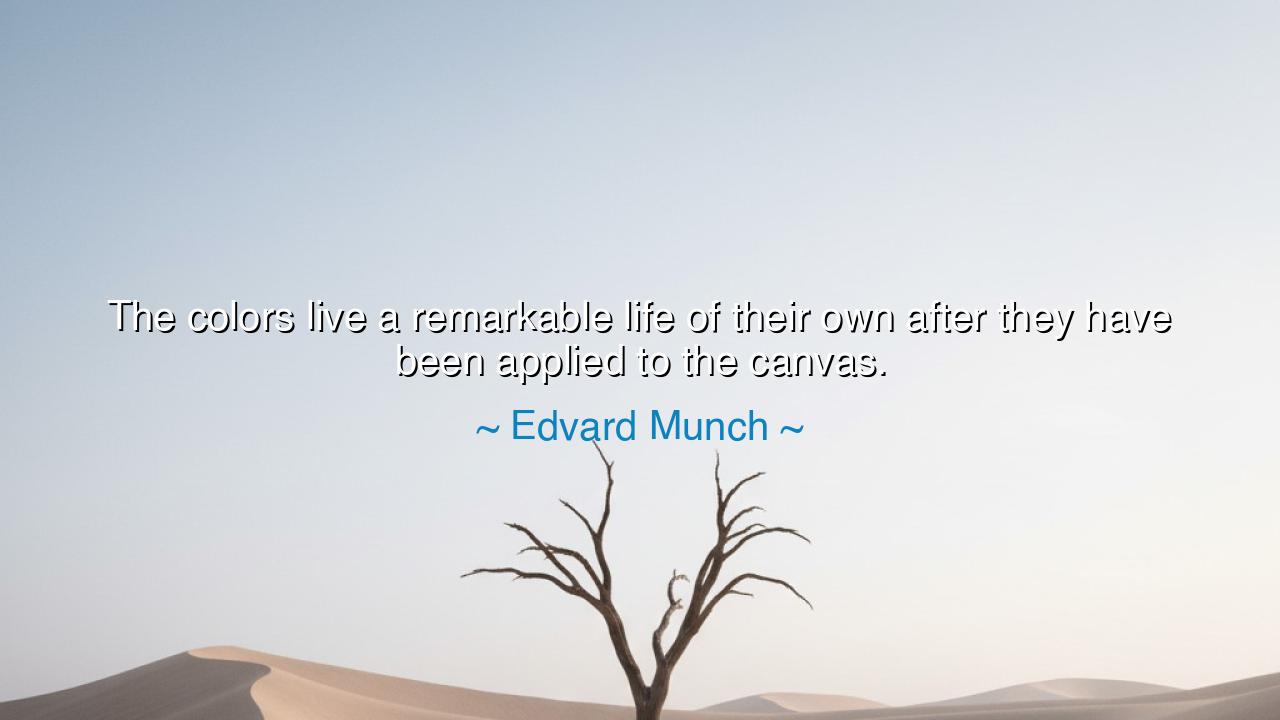
The colors live a remarkable life of their own after they have
The colors live a remarkable life of their own after they have been applied to the canvas.






Edvard Munch, painter of anguish and ecstasy, once declared: “The colors live a remarkable life of their own after they have been applied to the canvas.” In these words, he revealed a mystery that the ancients would have recognized—the truth that creation, once born, becomes more than the hand that shaped it. The colors, like fire once struck from flint, leap into life beyond the will of the artist. They speak, they breathe, they carry stories into the hearts of those who behold them. What was once mere pigment and brushstroke awakens into spirit, no longer bound by the creator, but moving freely in the world.
The ancients often spoke of art as divine possession. The Greeks believed the Muses whispered into the ears of poets and painters, filling their works with voices that did not belong to them alone. When Munch says that colors live a remarkable life, he echoes this ancient belief: that the work of art is not dead matter, but alive, infused with something greater than the human hand. The canvas becomes not an object, but a presence—a mirror that speaks, a fire that burns without consuming.
Consider Munch’s own most famous creation, The Scream. The swirling reds, the trembling yellows, the sky itself bleeding into terror—these colors live with a force that no explanation can tame. They frighten, they stir, they haunt generations who look upon them. Munch painted them once, yet they continue to scream centuries later, not with his voice alone, but with the voice of humanity itself. The colors on the canvas live their own life, independent, eternal, carrying emotions into the souls of all who encounter them.
This is not Munch’s gift alone. Think of Michelangelo, who lay on his back in the Sistine Chapel, his brush trembling across the vast dome. The colors he laid—blues of heaven, flesh-tones of Adam, the fierce reds of the Creator—still live centuries later. Pilgrims stand beneath them and weep, though Michelangelo has long turned to dust. His colors, though applied in one age, continue to live in another, speaking new truths, kindling new fires. The canvas, or the wall, becomes eternal breath.
Munch’s words are also a lesson about creation in all forms. Whether in painting, in writing, in music, or in deeds, what we set into the world takes on a life of its own. A word spoken in kindness may echo in a stranger’s heart for years. A story told may inspire actions far beyond what the teller imagined. Just as the artist does not fully control the colors once laid, so too do we not control the ripples of our actions. Creation, once released, belongs to the world, not to us.
The wisdom is clear: be mindful of the colors you cast upon the canvas of life. For they will live on, beyond your moment, carrying meanings you did not foresee. Paint with truth, act with love, speak with care—because once loosed, these colors will move where you cannot, shaping the souls of those who meet them. Munch reminds us that creation is responsibility, for it continues to live long after the hand has finished its work.
Practical actions follow. Whatever you create—whether it is a painting, a word, a gesture, or a legacy—imbue it with honesty and depth. Do not dismiss small acts, for even the faintest hue may live beyond you. Reflect upon what you leave behind each day, and ask: Will this inspire, will this heal, will this endure? For as Munch teaches, once the colors are on the canvas, they are no longer yours—they belong to the great story of humanity.
O seeker, carry this wisdom: the colors live. What you set into the world will live beyond your knowing. Therefore, create bravely, love fiercely, speak truthfully. For the strokes of your life’s brush are not forgotten—they awaken, they breathe, they live. And through them, though your hand one day will still, your spirit will continue to echo in the living canvas of the world.






AAdministratorAdministrator
Welcome, honored guests. Please leave a comment, we will respond soon